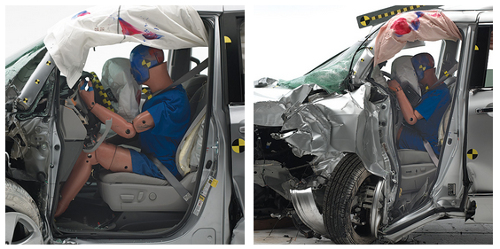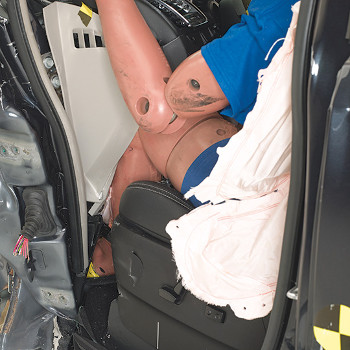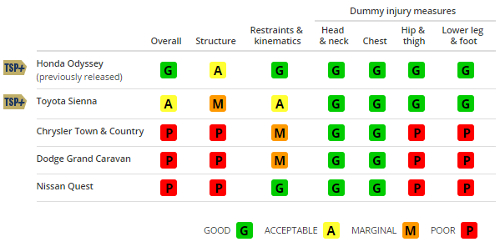 |
| December 23, 2014 | Volume 10 Issue 48 |
Designfax weekly eMagazine
Archives
Partners
Manufacturing Center
Product Spotlight
Modern Applications News
Metalworking Ideas For
Today's Job Shops
Tooling and Production
Strategies for large
metalworking plants
Minivans come up dangerously short in latest IIHS small overlap tests
A group of four minivans recently tested by the Insurance Institute for Highway Safety (IIHS) for protection in small overlap front crashes shows some of the worst possible outcomes for this type of crash, with only one vehicle performing acceptably.
The Nissan Quest, the Chrysler Town & Country and its twin, the Dodge Grand Caravan, all earn poor ratings. The exception to the disappointing pattern is the 2015 Toyota Sienna, which earns an acceptable rating. It joins the Honda Odyssey, which last year earned a good rating in the small overlap crash test, in the ranks of TOP SAFETY PICK+ award winners.
"Minivans are popular among parents, a group that tends to be safety conscious, but we've only seen two so far that offer decent protection in small overlap crashes," says David Zuby, IIHS executive vice president and chief research officer.
In the small overlap test, which replicates what happens when the front corner of a vehicle collides with another vehicle or an object such as a tree or a utility pole, the crash forces bypass the vehicle's main energy-absorbing structure. These crashes may be especially difficult for minivans to handle. That's because minivans are typically built on car platforms but are wider than cars. As a result, more of the vehicle is located outside the main structure. Minivans also are heavier than cars.
In the case of the Sienna, Toyota modified the front structure of the 2015 model to improve small overlap protection. Still, it didn't hold up that well in the test, with intrusion measuring as much as 5 1/2 inches at the upper door hinge pillar and instrument panel. The dummy's head contacted the front airbag but immediately slid off the left side. The safety belt also allowed the dummy to move too far forward. On the plus side, the side curtain airbag deployed and had sufficient forward coverage to protect the head from intruding structure. Measures taken from the dummy showed that the risk of any injuries would be low in a crash of this severity.
While the Sienna managed an acceptable rating despite subpar structural performance, all bets were off for the Quest. The structure was pushed in nearly 2 feet at the lower hinge pillar, and the parking brake pedal moved 16 inches toward the driver. The dummy's left leg was trapped between the seat and instrument panel, and its right foot was caught between the brake pedal and toe pan. Following the tests, technicians had to cut the entire seat out and then use a crowbar to free the right foot.
The Quest receives a good subrating for restraints and kinematics, but that is deceiving. This component of the rating measures how well the safety belt and airbags work to control the dummy's movement. In the Quest, the dummy was held in place by the intruding structure, and the airbag was shoved into its face.
"That kept the measured risk of head injury low, but that's about the extent of what can be expected from the restraint system when the basic structure collapses so completely," Zuby says.
The forces measured all along the dummy's left leg, from the thigh to the foot, were very high, in some cases exceeding the limits of the sensors.
"A real person experiencing this would be lucky to ever walk normally again," Zuby points out. A broken right femur also would be possible. The Quest's poor rating applies to 2011-15 models.

The door hinge pillar and instrument panel were pushed in 5 1/2 inches during the test of the Toyota Sienna (left), but the minivan still managed an acceptable rating overall. Intrusion in the poor-rated Nissan Quest (right) was much worse, reaching nearly 2 feet and completely trapping the dummy's left leg.
The Town & Country's structure also collapsed around the dummy. Intrusion measured 15 inches at the lower hinge pillar and the instrument panel. The skin on the dummy's left lower leg was gouged by the intruding parking brake pedal, and its left knee skin was torn by a steel brace under the instrument panel. The head barely contacted the front airbag before sliding off and hitting the instrument panel, as the steering column moved to the right. The door sill and the steering column both moved in toward the driver. The side curtain airbag deployed but lacked sufficient forward coverage.
Measures taken from the dummy indicate that injuries to the left hip, left knee, and left lower leg would be likely in a crash of this severity. As with the Quest, some of the forces were off the scale.
These results apply to the 2008-15 Town & Country and the 2008-15 Grand Caravan. (They also apply to another, discontinued twin, the 2009-12 Volkswagen Routan.)

The structural collapse of the Chrysler Town & Country was so severe that the dummy's tough skin was torn in two places on the left leg by intruding structure.
The only minivan sold in the U.S. not rated by the Institute is the Kia Sedona. The manufacturer has told IIHS it plans to make a change to the vehicle in the coming weeks to improve small overlap protection, so it will be tested shortly.
The Institute introduced the small overlap front test in 2012. In the test, which is more challenging than either the head-on crashes conducted by the government or the Institute's moderate overlap front test, 25 percent of a vehicle's front end on the driver side strikes a rigid barrier at 40 mph.
Vehicles with a good or acceptable small overlap rating, along with good ratings in the moderate overlap front, side, roof strength, and head restraint tests, qualify for the 2014 TOP SAFETY PICK award. Vehicles that meet those criteria and also earn a basic or higher rating for front crash prevention qualify for the TOP SAFETY PICK+ award.
The Sienna earns its "plus" on the basis of an advanced front crash prevention rating. Its optional system includes forward collision warning and an automatic braking function that reduced impact speeds by an average of 9 mph in the Institute's 12-mph test and by 7 mph in the 25-mph test.

Minivan ratings in small overlap front test
Source: Insurance Institute for Highway Safety
Published December 2014
Rate this article
View our terms of use and privacy policy
